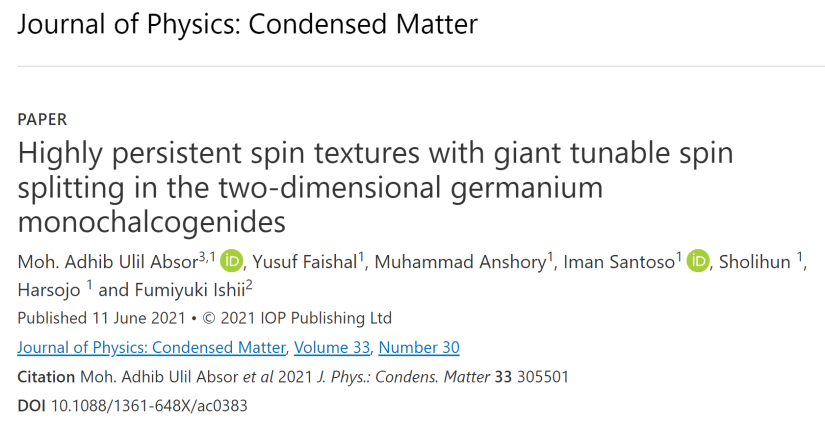
Moh. Adhib Ulil Absor, Yusuf Faishal, Muhammad Anshory, Iman Santoso, Sholihun, Harsojo, Fumiyuki Ishii
DOI 10.1088/1361-648X/ac0383
Journal of Physics: Condensed Matter
Volume 33, June 2021, 305501
Abstract
The ability to control the spin textures in semiconductors is a fundamental step toward novel spintronic devices, while seeking desirable materials exhibiting persistent spin texture (PST) remains a key challenge. The PST is the property of materials preserving a unidirectional spin orientation in the momentum space, which has been predicted to support an extraordinarily long spin lifetime of carriers. Herein, by using first-principles density functional theory calculations, we report the emergence of the PST in the two-dimensional (2D) germanium monochalcogenides (GeMC). By considering two stable formation of the 2D GeMC, namely the pure GeX and Janus Ge2XY monolayers (X, Y = S, Se, and Te), we observed the PST around the valence band maximum where the spin orientation is enforced by the lower point group symmetry of the crystal. In the case of the pure GeX monolayers, we found that the PST is characterized by fully out-of-plane spin orientation protected by C2v point group, while the canted PST in the y–z plane is observed in the case of the Janus Ge2XY monolayers due to the lowering symmetry into Cs point group. More importantly, we find large spin–orbit coupling (SOC) parameters in which the PST sustains, which could be effectively tuned by in-plane strain. The large SOC parameter observed in the present systems leads to the small wavelength of the spatially periodic mode of the spin polarization, which is promising for realization of the short spin channel in the spin Hall transistor devices.
